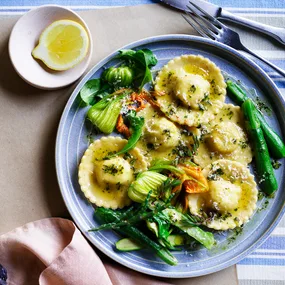If I were asked to name my favourite section in French cuisine it would have to be charcuterie. While it shares the precision of the pastry kitchen, it enjoys the creativity and surprise of the sauce section. There are endless possibilities of flavour and texture as well as presentation, from the humble, everyday terrine to grand masterpieces such as a duck galantine – the bird boned and stuffed with a pork, duck and foie gras farce, and sometimes truffles, for special occasions such as Bastille Day or New Year’s Eve.
Sausages using all manner of meat, poultry, game and seafood can be found in the charcuteries of every French city and village, along with regional specialities. Though charcuterie means “cooked flesh” (chair meaning “flesh” and cuit “cooked”), it principally applies to pork-based products. Sausages without skins fall into the category of crépinettes (faggots in the UK), the name drawn from crépine, meaning caul or lace fat. A membrane flecked with fine lines of snowy white fat, caul fat is used to encase sausage meat and it melts when cooked, providing both moisture and extra flavour. Gayettes are crépinettes formed into small rounded triangles about 2.5cm thick – though the shape distinctions can be blurred – and lend themselves to a wide range of flavours.
Gayettes de Provence call for pork liver and both lean and fat pork; the addition of Swiss chard, garlic and thyme makes them Provençale. I take the flavour spectrum a little further by adding a little aniseed flavour in the form of Ricard pastis, made in Marseille. Traditionally, gayettes are cooked in animal fat or olive oil and served cold as part of an hors d’oeuvre. They are very good served with a gratin of waxy potatoes enriched with herbs, garlic and olive oil. One may substitute duck or chicken livers for the pork liver for a lighter flavour, which would extend the yield from game birds such as the small and expensive squab.
Jane Grigson, in her fine book Charcuterie and French Pork Cookery, includes some seven recipes for gayettes and crépinettes as well as the British faggot. At my Sydney restaurant Bistro Moncur, in the early 1990s, we made large quantities of crépinettes and gayettes, and cooked them immersed in duck fat, then stored them under a thick layer of clarified duck fat to improve the flavour. Reheating was simply done in a pan over low heat and a brief visit to a hot oven.
I would encourage readers to experiment, keeping to the ratio of fat to lean meats in this recipe. It is good to remember that fat plays an important role in the preservation of charcuterie, together with salt and alcohol, and provides a richer flavour. I use the traditional ratio of two per cent salt to solid meat weight, but the ratio could be reduced to 1.6 per cent (16gm per kilo) to taste.
These gayettes will add a wow-factor to your summer barbecues, and need only a touch of mustard. And you could accompany them wtih a delicious potato salad instead of the gratin of potatoes included here. Cook kipflers as directed and turn them out onto a platter rubbed with a smashed garlic clove, then sprinkle them lightly with dry white wine, and salt and pepper. When the potatoes have cooled a little, add finely sliced shallots, cornichons and plenty of chopped parsley, and bind them with a small amount of mayonnaise or thick yoghurt. Delicious casual summer eating.
Ingredients
Method
Main
Note Begin this recipe a day ahead to marinate the meat. Pig’s livers weigh 1kg-1.2kg and contain lots of tubes. Unlike calf’s livers they don’t require skinning. Because less than half the weight is required (and the product is inexpensive) you can be extravagant and select only the pure flesh. Cut 2cm slices across the narrower width, then cut around the tubes to achieve 550gm. Order back fat and caul in advance from your butcher. Herbes de Provence are available from select spice specialists; Pignolet prefers A L’Olivier brand, available from Gourmet Life. He makes his own quatre-épices by grinding seven parts allspice with one part each of nutmeg, cloves and cinnamon in a spice blender.
Notes










